Types of Blockchain
There are different types of Blockchains that are currently available in the market. Over the years, the world of Blockchain evolves manifold. Let’s have a look over some of the types of Blockchains:-
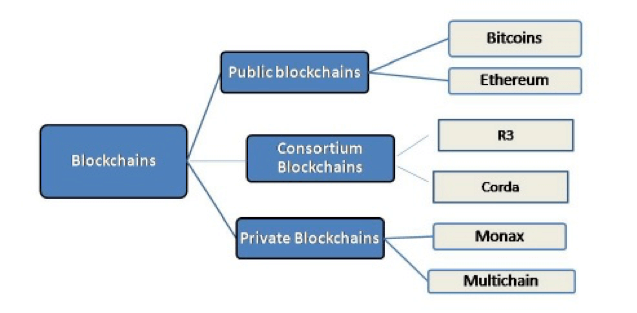
1. Public Blockchain
These Blockchains are acknowledged to be Permissionless Blockchain. By Permissionless Blockchain network, we mean that anyone is allowed to participate in the network. Anyone can indulge in the network as a node and can conduct transactions. Users may or may not be rewarded for participation in the network. A public Blockchain is a completely decentralized network where members can download the software on their personal computers and track the record. The data is shared among the participants and all of them can see and participate in the ongoing transaction. The ledgers of the public Blockchain are not being maintained by anyone and it is completely open and anyone can participate. All users are allowed to download a copy of the ledger on their local computer and they can analyze all the ongoing transactions on the network. However, the distributed consensus mechanism is being maintained in order to reach the final decision.
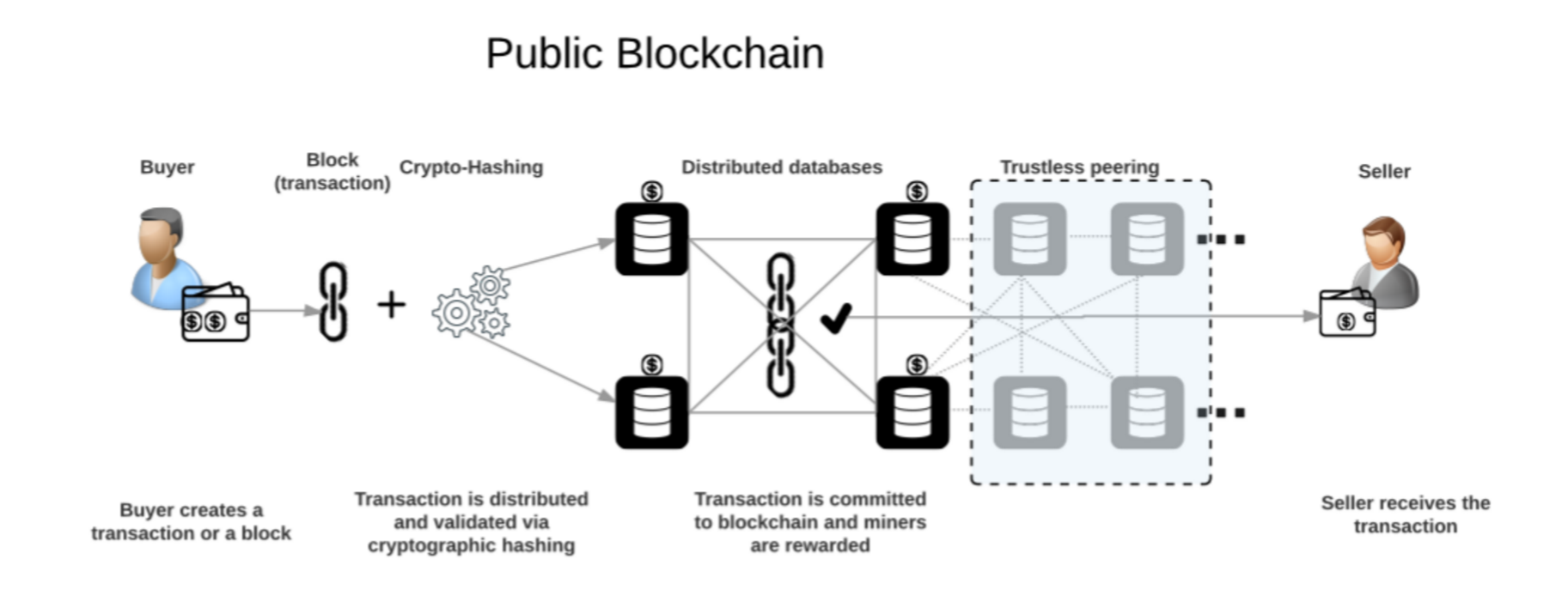
The public Blockchain is mainly of two types
Bitcoin & Ethereum
Both of these are the public nature of the Blockchain network where any user can participate in the network to carry out the transaction without the need for a third party. The public Blockchain entirely eliminates the requirement of the third party. It is also very easy to use and quite accessible.
It is immensely hard to hack the public Blockchain as thousands of users are involved in the transaction. To hack this complicated and distributed system hackers have to spend a large amount of money. Moreover, once a block is hacked it’s the coin’s value will diminish exponentially which will let hackers to incur a huge loss. Therefore hackers hesitate to hack such types of systems.
In the public network, each transaction needs to be verified by thousands of participants, therefore the verification process becomes time-consuming. Besides this, the transaction fee is comparatively higher in the public Blockchain network as compared to the private Blockchain network.
2. Private Blockchain
A Private Blockchain is being opened to a group of people or consortium that has agreed to share the ledger with each other. The private Blockchain network is secured than the public Blockchain network. In a private Blockchain network, only a group of people who have agreed to share the ledger are indulged in the network. Also, in such Blockchain, people have mutually agreed to trust on an organization that is trusted and certified. This organization has given the authority to allow participants to read a particular transaction as all transactions are not necessary for participants to be read. Moreover, private network endows more privacy to the members.
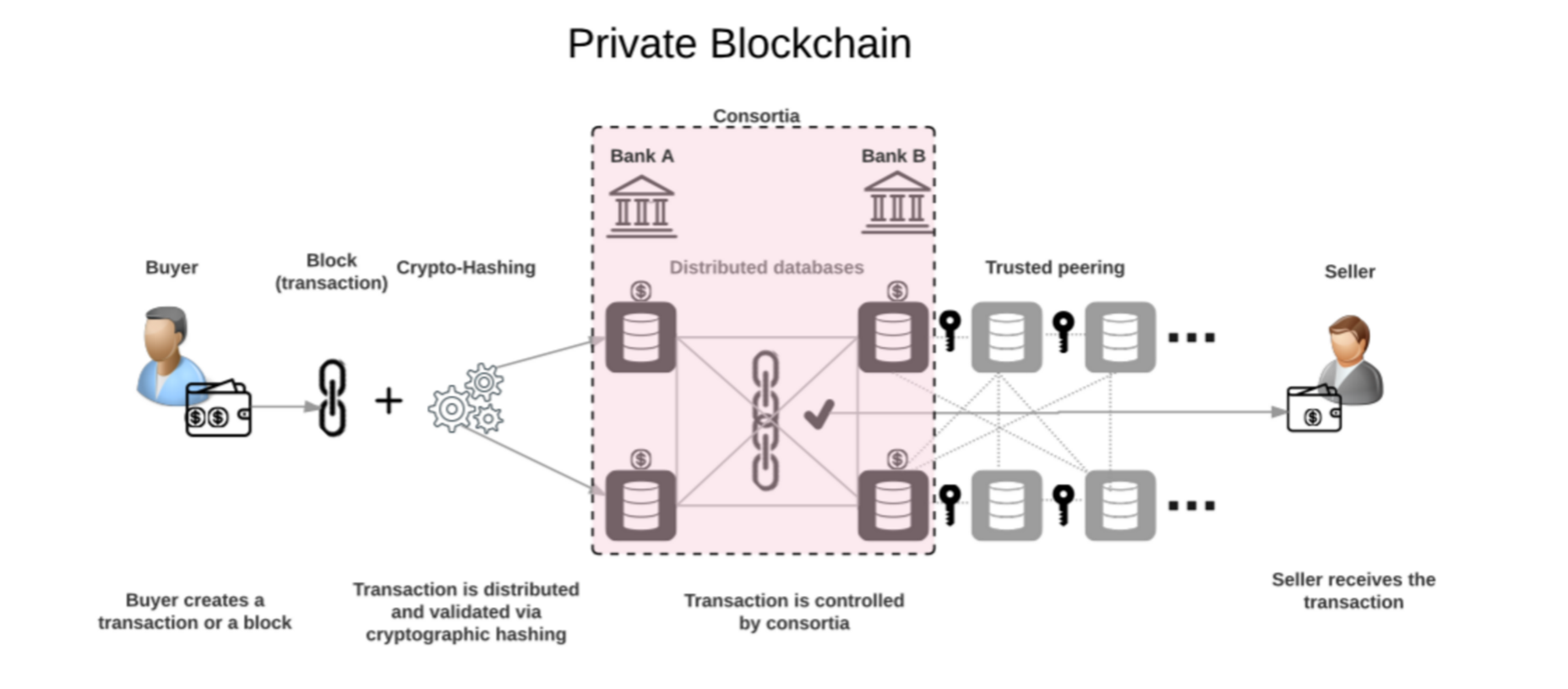
Comparing to the public network, the private network is more quick and more secure as only a limited number of people are taking part in such a model. With the limited number of nodes, the transactions in the private network are quick and in case if any fault surfaces in the network then it can be easily rectified. However, a private Blockchain network does require someone to confirm the transaction.
Those businesses who want to set up a private Blockchain network will set up the business Permissioned network. In this type of network, restrictions are being put on people who can participate in the network. Participants can take part in the network if they are allowed by the head of the network and in case they want to join the network they will need special permission to join the network. The private Blockchain network is a useful network. It is a much more secure and trusted network as compared to a of the public Blockchain network.
The benefit of the private network is that only a few people can take part in this network. The transactions are totally secured and confidential only those people who are indulged in the transaction can see the transactions. Without permission, the third person is not authorized to see the transaction. The information is being sent over the network which is completely secure and it is hard to break the system. Another benefit of this network is that the information under such a network can’t be hacked because it is sent in the form of cryptography which is very secure and very difficult to be hacked.
Thus, participating in the private Blockchain network is trusted and secure as nobody else will get to know about your transactions. Banks and financial institutions use private Blockchain instead of public Blockchain in order to make banking transactions safer. The reason behind using private Blockchain is that information does not share between the third party and it remains totally unfolded.
Apart from this, private Blockchain offers numerous advantages to small business traders too.
3. Consortium Blockchain
This kind of Blockchain falls between the public and private Blockchain. It is called partial public and private Blockchain. In this Blockchain, several selected members are allowed to share the ledger leaving other members aside. These members are given full control to share the ledger and oversee the transactions.
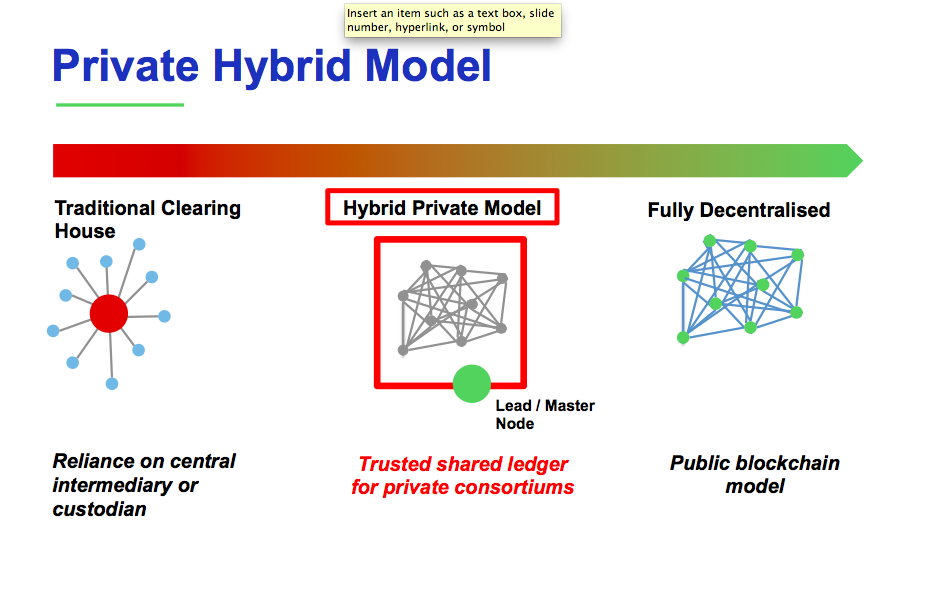
The consortium Blockchain is one in which control is not being given to one company, but it is divided between more than one person. Alike private Blockchain in Permissioned Blockchain user and data privacy is being maintained.
Blockchain components
There are various Blockchain components that are available in the market. Some of them are mentioned and discussed briefly below:-
- Ledger
- Smart Contract
- Consensus Network
- Membership
- Events
- System Management
- Wallet
- System Integration
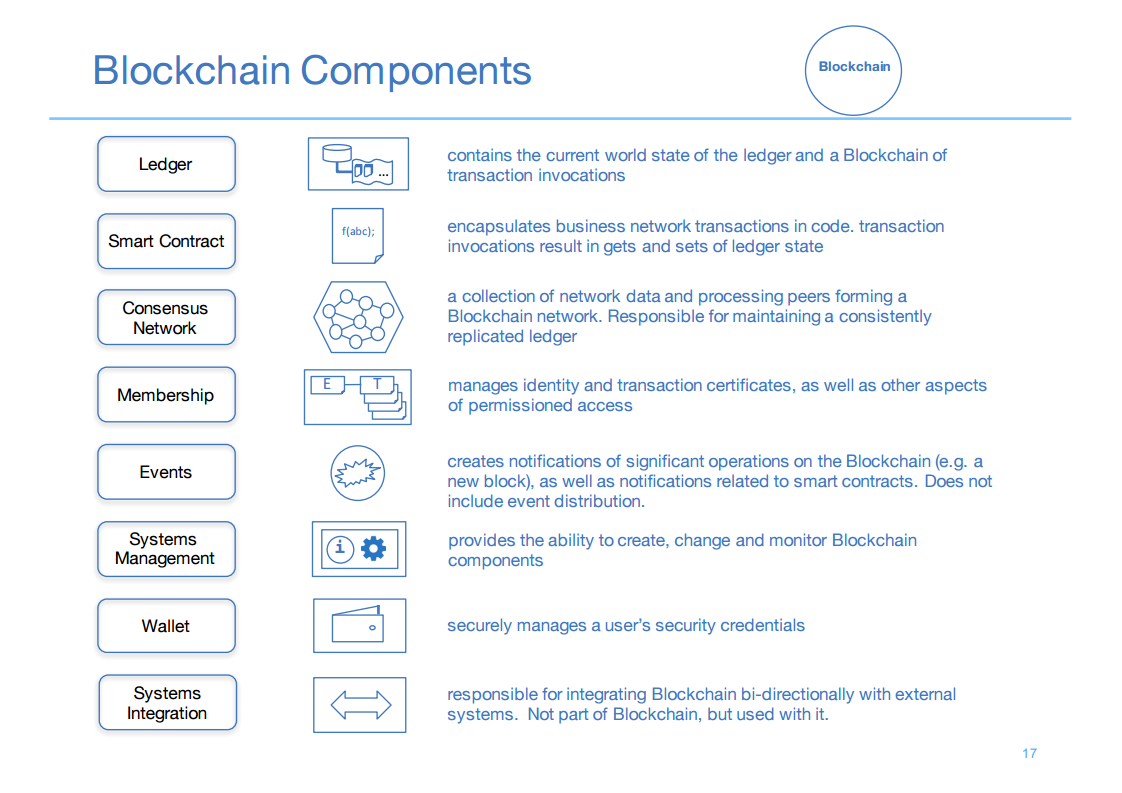
1. Ledger
Business ledgers are an important part of any business. Ledger contains all the records of the transaction in both the offline and online worlds. In Blockchain, the technology ledger contains the record of all transactions and participants are given permission to oversee the transactions. There are two types of ledger public and private or business ledger. In a public network, all participants or members are allowed to look at all the ongoing transactions. However, in some cases, members are refrained from looking at the details of the transaction between two members.
For example, let’s say there are two participants A and B indulge in a transition, now C another participant wants to see the details of the transaction, however, he won’t be permitted to look at the details of the transaction, but he can see that transaction has happened between two members. The shared ledger is a distributed network that lists down the rules every ledger contains to support the security of the network. For example, if you are running the Bitcoin application then you have to follow the rule set by the network administrator for Bitcoin application.
2. Smart Contract
A smart contract is a legal document that allows sharing of money, property, and other valuable assets without the indulgence of the middleman. This is a great technology because it reduces or devoid the chances of fraud or illegal activities. A suitable way to define the smart contract is to compare it to the vending machine.
Suppose if you want to create a driving license or buy property, you need to go to a lawyer, however, with Bitcoin technology, you need only to insert a coin in the vending machine and you can escrow driving license and other documents. In other words, the smart contract is like the traditional document to define rules and regulations but it automatically enforces those obligations. This feature has already helped many of Blockchain users in a situation where legal proof is required.
3. Consensus Algorithm
The consensus algorithm is a group of rules and laws that run a Blockchain. The term consensus refers to aggregate decisions or agreements between different people over the set of rules and regulations to conduct a Blockchain. A distributed consensus is a system in which more than a computer or node is allowed to take part in the overall decision-making. All these nodes mutually consent to reach a decision. The distributed consensus works parallel to the way humans work.
4. Membership
Every Blockchain is assigned a unique identity that differentiates it from the other Blockchain service that is available for users. All participants of the Blockchain are being given permission to use the network by assigning a unique identity. There is a renowned agency or trusted agency which issues certificates to Blockchain for operations.
5. Events
Events are also an important part of Blockchain technology. It is useful as it gives notifications of all the important operations on the Blockchain. For example, if there is a transaction occurring in the Blockchain it will give you a notification. However, event distribution is not part of this technology.
6. System Management
It is also one of the prominent aspects of the Blockchain network. System management or manager defines, create, modifies or removes the rules. A system manager has broad responsibility. He is being given the authority to make sure that error-free operations happen on the Blockchain.
7. Wallet
The wallet is also an important component of the Blockchain. Each member of the Blockchain is given a wallet that securely maintains all records of the user. It confines security to all the details of the user and also secures the credential of all the participants.
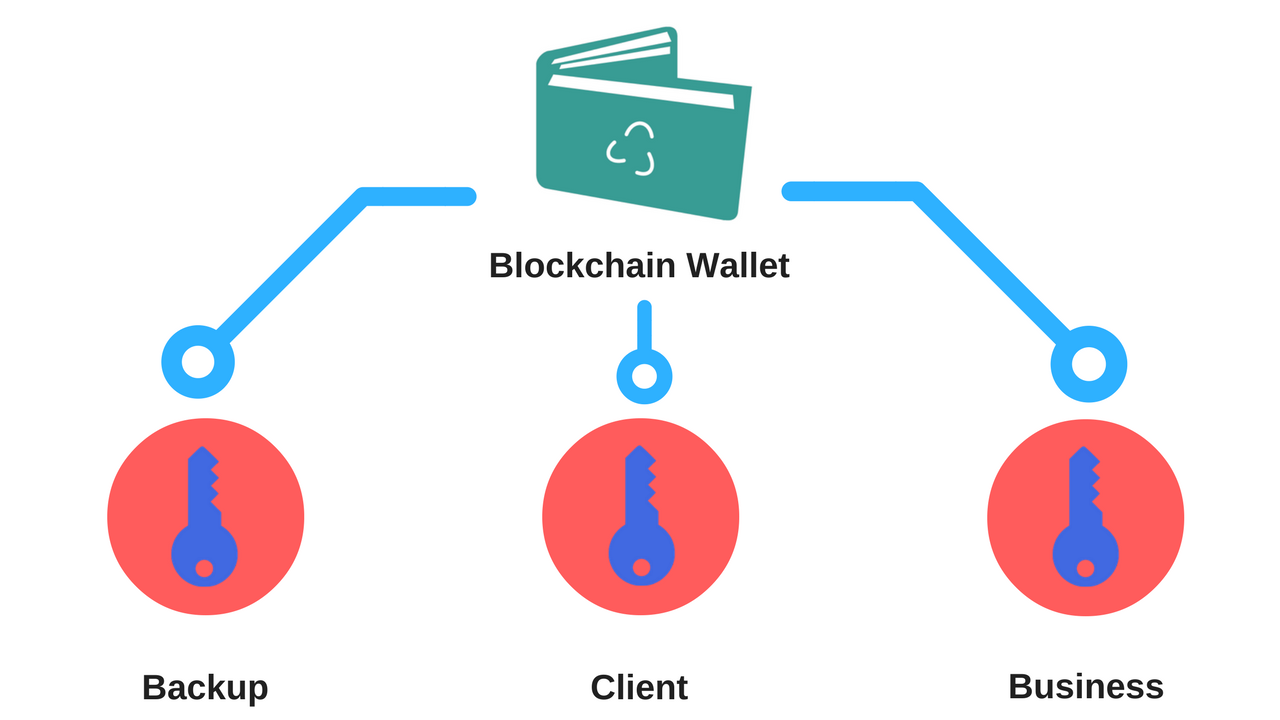
8. System Integration
Sometimes, it is required to combine a Blockchain bi-directionally with an external system. It is not part of the Blockchain system but can be used with it.
I am Pawan Kashyap currently living in Amritsar. I always try to grab new things from the cryptocurrency market. From my observations and trends in the market, I always try to provide the best and accurate information in the form of articles from this blog. Follow us on Facebook, Instagram, and Twitter to join us.







